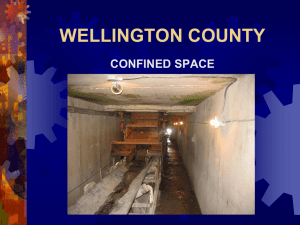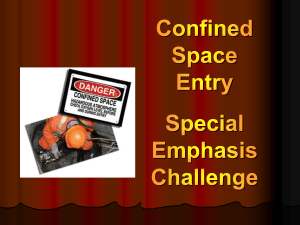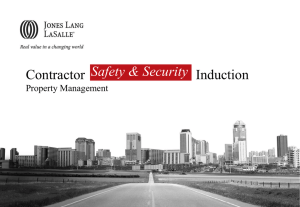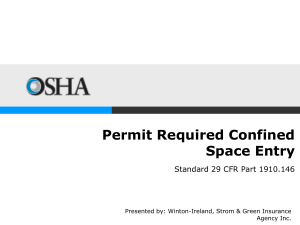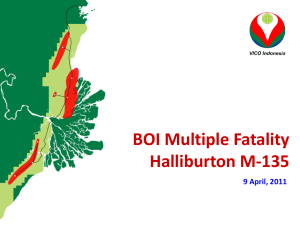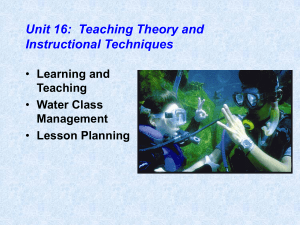printable version - Environment, Health and Safety
advertisement
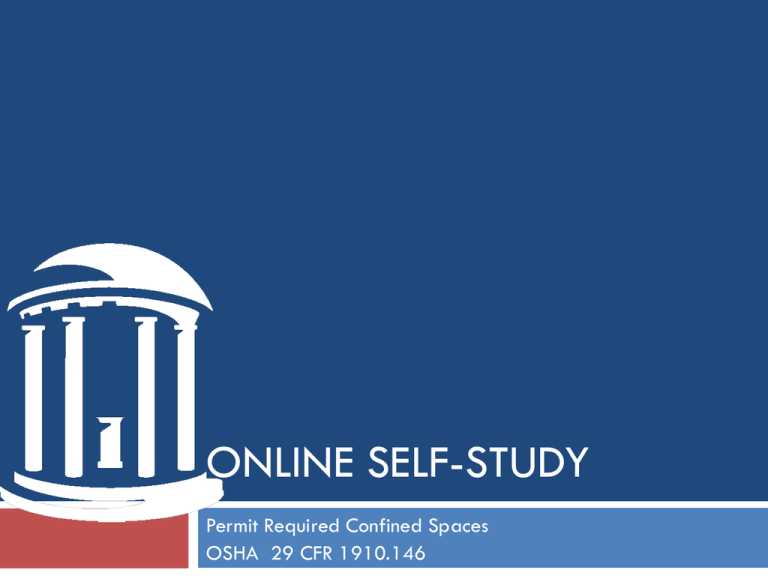
ONLINE SELF-STUDY Permit Required Confined Spaces OSHA 29 CFR 1910.146 Objectives In this course, we will cover the following: Definition of a confined space Identify the difference between a confined space and permit required confined space Discuss potential confined space hazards Outline responsibilities for the entrant, attendant and entry supervisor Identify rescue options Identifying a Confined Space What is a confined space? A confined space is a space that: is large enough to get the whole body inside and perform work, is not designed for continuous occupancy (i.e., primary function is not for human occupancy), and has limited or restricted entrance or exit. It must have all three characteristics to be a confined space. Identifying a Confined Space What is limited or restricted entry or exit? Physical configuration that requires a person to twist or contort the body or use hands to enter or exit the space. Safe egress is restricted by obstructions within the space or by the distance to reach the exit. Note: Entry is defined as breaking the plane of a confined space with any part of the body. Restricted exit Exit not restricted Identifying Confined Spaces Examples of confined spaces Manholes & Sewers Tanks Boilers Grain storage bins Other examples include vaults, pipelines, tunnels, and open top spaces >4 feet deep Identifying Confined Spaces UNC-CH departments shall identify each space under their jurisdiction which meets the definition of a confined space, if any exist, and shall provide a list of such spaces to EHS. The hazards of each permit space shall be catalogued on the list. Contact EHS (962-5507) for assistance with classifying confined spaces. Confined spaces shall be considered hazardous until an evaluation is completed. Hazards of Confined Spaces Confined spaces can be deadly. Some confined spaces are more hazardous than others. Confined space conditions can change rapidly from no hazards to life-threatening hazards. Some confined spaces are so hazardous, a written permit system is required for entry. The hazards of confined spaces can often be controlled or eliminated before entering. Hazards of Confined Spaces What are the main hazards of confined spaces? • Hazardous atmospheres • Engulfing materials • Entrapment • Mechanical (moving parts) • Electricity Hazards of Confined Spaces What makes confined spaces so hazardous? Analysis of 10 years of oxygen deficiency fatalities related to nitrogen asphyxiation revealed: In 80% of the incidents, the confined space had been entered before without any problems by the same person who died. In 40% of the incidents, the hazard was not present at the time of initial entry. In 89% of the incidents, the entries were authorized by supervisors. In 35% of the incidents, the fatalities were supervisors. Source: AIHA-Challenging Confined Spaces Teleweb Hazard of Confined Spaces When is a confined space so dangerous a written entry permit system is required? • When there is an actual or potential “hazardous atmosphere”, or • When the space contains material that can engulf a person, or • When the space is configured in a way that can trap a person, or • When there is any other recognized serious safety and health hazard. Hazard Identification A “hazardous atmosphere” in a confined space has one or more of the following: Flammable gas, mist or vapor Flammable dusts Oxygen content below 19.5% or above 23.5% Air contaminant concentrations that would cause death, incapacitation, or permanent health problems You must do air monitoring to determine if a hazardous atmosphere exists. Hazard Identification Hazardous Atmospheres – Flammable Gases, Vapors and Dusts Flammable gases, vapors or dusts will ignite from a spark or flame if above a level in the air called the “lower flammable limit” (LFL). Gas or vapor levels higher than 10% of the LFL are considered hazardous and the confined space cannot be entered until levels are reduced. The LFL and upper flammable limit (UFL) set the boundaries of the flammable range. LFL is sometimes called “LEL” – “lower explosive limit” Hazard Identification Example of flammable gas levels - Methane Air 0% Air 100% Too Rich Too Lean Boom! Methane 0% 5.3% LFL Methane 100% 15.0% UFL An open flame or a spark will cause an explosion when the methane amount is between 5.3% and 15% (i.e., the LFL and UFL for methane). Hazard Identification Hazardous Atmospheres – Oxygen Deficiency A reduction in oxygen may be caused by lack of ventilation, rusting, microbe activity, or replacement by another gas. Lack of oxygen can cause a person to immediately collapse and die. Normal air contains 21% oxygen. A space with oxygen content below 19.5 % is considered “oxygen deficient”. 21% 19.5% 0% Oxygen content Oxygen deficiency exists Hazard Identification Effects of Oxygen Deficiency % Oxygen Symptoms 19.5% - 16% Fatigue, mild impaired coordination 16% - 12% Increased breathing rate and pulse; impaired coordination, perception or judgment 12% - 10% Further increased breathing rate, blue lips, mental confusion 10% - 8% Fainting, nausea, vomiting, mental confusion within few minutes 8% - 6% Collapse, death within 8 minutes 6% - 0% Coma within 40 seconds, death Using an “inerting gas” like nitrogen to counteract flammable vapors will result in an oxygen deficiency. Hazard Identification A word about oxygen-enriched atmospheres A confined space with an oxygen amount above 23.5% is considered “oxygen-enriched”. A potential source of “extra” oxygen is a leaking oxygen cylinder used for an oxy-acetylene torch. Oxygen above 23.5% is a fire or explosion hazard. Green tanks contain oxygen Hazard Identification Hazardous Atmospheres – Toxic Chemicals At very high levels, chemicals in the air can be immediately life-threatening or cause permanent bodily harm. Even at lower levels, chemicals in the air can still cause harm. Some chemicals have “occupational exposure limits” (OELs) which will cause harm if exceeded. Even non-toxic or low-toxic chemicals can replace oxygen if levels are high enough. Hazard Identification Hazardous Atmosphere – Toxic Chemicals The most common toxic chemicals in confined spaces fatalities are hydrogen sulfide and carbon monoxide. Other toxic chemicals can include welding fumes, vapors from liquid residues in storage tanks, or chemical products used in the confined space. Chemicals can quickly reach toxic levels in the air of a confined space, especially gases, solvent vapors or sprayed products. Contact EHS (962-5507) for more information on toxic chemicals. Hazard Identification Hazardous Atmospheres–Hydrogen Sulfide (H2S) Hydrogen sulfide gas is produced by decaying matter and is commonly found in sewers. It can be instantly fatal at higher levels in a confined space. The OELs for H2S prescribed by EHS are 1 ppm as a 8-hr TWA1 and 5 ppm as a 15-min STEL2. 30 100 200 600 1000 2000 H2S in parts per million (ppm) Smell strong odor Loss of smell Coughing, red eyes Unconscious in 30 min. Instant collapse Death in minutes 1 Time-Weighted Average, 2 Short-Term Exposure Limit Hazard Identification Hazardous Atmospheres – Carbon Monoxide (CO) Carbon monoxide comes from operating internal combustion engines in or near a confined space. Propane-powered engines also emit carbon monoxide. Fatal levels of CO are quickly reached in confined spaces. The OEL for CO is 25 ppm as an 8-hr TWA. To see the effects of CO, click here Hazard Identification What are the Hazards of Engulfing Material? Engulfing materials include liquids or loose solids such as grain, sand or other granular material. People cannot escape when caught in moving loose solids and can suffocate. Workers often get engulfed when inlet or outlet lines are inadvertently opened or activated. Hazard Identification What is Entrapment? The space is configured in a way that can trap a worker, for example, sides sloping towards the center Gravel hopper Sawdust Cyclone Hazard Identification Other Recognized Hazards Electrical lines, steam lines or hydraulic lines Mechanical hazards (moving parts) Hazards caused by the work (welding, painting etc.) Controlling the Space The hazards of a confined space can be controlled in the following ways: • Prevent employee entry. • Remove or reduce hazards in the space first, before a person enters. • If hazard cannot be removed or controlled, you must use a written permit system to enter safely. Controlling the Space Warning employees and controlling access Post warning signs at the entrance of confined spaces. Limit employee access to confined spaces by using entry barriers or locks. Make sure that unauthorized workers do not enter the confined space. Hazard Control How To Control Hazardous Atmospheres Drain or pump out liquid contents, if any. Blank off all in-feeding lines. Test air and ventilate. Continue ventilating constantly. If possible, remove any sludge from outside the confined space. Exit space if conditions deteriorate. Hazard Control Hazardous Atmospheres Dangers It is difficult to eliminate hazardous atmospheres in most sewers lines. Tank sludge or sewer sludge can release toxic gases during cleanup. Toxic or flammable gases can exist in pockets or layers within the space. Hazard Elimination How To Eliminate Physical Hazards Lock-out and Tag-out moving parts Blank or block steam pipes and product in-feeding pipes. De-energize electrical parts or wiring If Hazards Can’t Be Eliminated If hazards cannot be completely eliminated, there are only two options: a complete written permit system, or “alternate procedures.” Both require training of employees. Entry into a Confined Space How is entry into a confined space classified? Written Permit System – required for any high hazard entry Alternate Entry Procedures – allowed for controlled atmospheric hazards only Reclassified Non Permit – allowed only if all hazards are eliminated Hazards must be determined before entering a confined space. Confined Spaces Entry Procedures What Determines Your Options If the atmosphere can’t be controlled or there are other uncontrolled hazards, you must use the written permit system for entry into a confined space. If you are unsure about the hazards, you must assume a high hazard and use a written permit system for entry. Only if you are sure there are no hazardous atmospheres or other hazards, can you avoid the required permit procedures for entry. Confined Space Entry Procedures What are “alternate entry procedures”? If the only hazard is atmospheric (toxic gas or oxygen deficiency) and it is controlled by continuous ventilation, then you may use less restrictive alternate entry procedures. These procedures have fewer requirements. Don’t assume that the only hazard is atmospheric without investigation and reliable information. Confined Space Entry Procedures What are alternate entry requirements? Employees must be trained on confined space hazards, The atmosphere in the confined space must be tested before and during entry, Continuous ventilation must be used, If a hazardous atmosphere is detected, or ventilation stops, the space must be promptly exited. Confined Space Entry Procedures What are alternate entry requirements? The acceptable concentration for LEL is lowered to <5% as a protection factor. Provide vehicle and pedestrian barriers. No harness or lifeline required. However, EHS recommends entrants wear a harness and a have a retrieval device in the vicinity to aid in rescue during medical emergencies such as heart attacks. Confined Space Entry Procedures What are reclassified non-permit entry requirements? If all hazards are eliminated (as opposed to controlled), then you may reclassify a space as non-permit. OSHA expects that this option will apply primarily to spaces containing hazardous energy sources or engulfment hazards. Employees must be trained on confined space hazards. The atmosphere in the confined space must be tested before and during entry. If the gas monitor alarms the entrant must evacuate the space and reclassify the space as a permit space until the contaminant is identified and eliminated. Confined Space Entry Procedures What are reclassified non-permit entry requirements? Acceptable atmospheric conditions are listed below: Oxygen between 19.5% and 23.5% Flammable gases (LEL) is at or lower than 10% Carbon monoxide is at or lower than 25 parts per million (ppm) Hydrogen sulfide is at or lower than 5 ppm Provide vehicle and pedestrian barriers. No harness or lifeline required. However, EHS recommends entrants wear a harness and a have a retrieval device in the vicinity to aid in rescue during medical emergencies such as heart attacks. Confined Space Entry Procedures The Importance of Air Monitoring Air monitoring is required whenever there is a possibility of hazardous atmospheres. Atmospheric conditions can change quickly in a confined space. A portable gas monitor with an alarm should be used by the person entering the confined space and checked frequently. Confined space gas monitor Confined Space Entry Procedures Acceptable Atmospheric Conditions Confined Space entry may proceed only if tests indicate: Oxygen between 19.5% and 23.5% Flammable gases (LEL) is at or lower than 10% Carbon monoxide is at or lower than 25 ppm Hydrogen sulfide is at or lower than 5 ppm The amount(s) of other identified air contaminants is/are at or lower than the OEL prescribed by EHS Detected hazards must be eliminated or controlled. Confined Space Entry Procedures Gas Monitor Alarm Setpoints Alarm setpoints must be set low enough to allow self-rescue before atmospheric conditions impair an entrant. EHS requires the following gas monitor alarm settings which are based on the most stringent OELs for the hazards: Sensor Low High STEL TWA O2 19.5 23.5 -- -- LEL 10 20 -- -- CO 25 100 100 25 H2S 5 10 5 1 Contact EHS (962-5507) for assistance with setpoints. Confined Space Entry Procedures Atmospheric Testing Frequency EHS recommends performing atmospheric tests every 5 mins for the first 20 minutes of the entry, then every 20 minutes thereafter. The testing frequency will help identify atmospheric changes before alarm setpoints on the gas monitor are reached. This frequency applies to testing for alternate entry procedures, reclassified non-permit, and permit-required spaces. Confined Space Entry Procedures Limitations of Air Monitoring Instruments LEL readings for gases other than the calibration gas may be incorrect. Temperatures outside of the operation range for the monitor may affect LEL readings. The presence of any detectable LEL indicates an abnormal condition and the source should be evaluated. Confined Space Entry Procedures The Importance of Daily Bump Testing Perform a daily bump test prior to using a gas monitor. On a given day, 1 in every 2,500 untested gas monitors will fail to respond to a dangerous concentration of gas. A bump test is a functionality test of sensors and alarms. Perform a bump test by briefly exposing the instrument to known concentrations of the target gases and verifying that the instrument responds. Source: Industrial Scientific Confined Space Entry Procedures Ventilation of Confined Spaces Fresh air blowers or exhaust fans are typically used. A blower intake must be placed in an area of clean air, (i.e., upwind of combustible engine exhaust). Exhaust ventilation must be used when welding or using chemicals in a confined space. Watch out for pockets of unventilated contaminated air. Don’t place a blower intake near a running engine! Written Permit Space Program If employees enter permit spaces, the employer shall develop and implement a written permit space program. Written Permit Space Program What are the goals of a written program? Identify and evaluate permit space hazards Ensure safe entry operations Provide proper entry equipment Designate and train entry team Develop rescue emergency procedures Perform annual program review Written Permit Space Program What is required in a written permit program? A written permit for each entry Extensive employee training Employee assigned duties The Written Permit The permit states what is done and who does it: Provides written entry authorization, Describes each individual’s roles and responsibilities, Specifies safety equipment and respiratory protection, Tells how long the job will take, States hazards found in the space. The Written Permit The written permit also includes the following: • Methods used to control the hazards • Acceptable entry conditions • Necessary equipment including PPE • Air monitoring testing results • Communication procedures • Name and telephone of the rescue service Designated Jobs Any permit-required confined space entry has designated jobs for employees: Entrant – person who enters into the permit space Attendant – person stationed outside the space who monitors the entrant Entry Supervisor – person responsible for planning, authorizing, and terminating the entry Each position has assigned duties. Permit System Job Duties Entrant’s Knowledge and Duties Knows and understand the hazards in the space, Knows and uses equipment properly, Is able to communicate with the attendant. Permit System Job Duties Entrant’s Knowledge and Duties Knows what the acceptable entry conditions for the space are, Knows how to contact the attendant if conditions become unacceptable, Exits the space when ordered, when alarm sounds, or when dangerous situation is noted. Permit System Job Duties Attendant’s Knowledge and Duties Knows and understands the hazards in the space, Knows the behavioral effects from exposures to hazards in the space, Knows and tracks who is in the space at all times, Warns away an unauthorized person who gets near or enters the space. Permit System Job Duties Attendant’s Knowledge and Duties Remains outside the confined space at all times and monitors activity constantly, Communicates with entrants to monitor conditions and knows when to order an evacuation, Knows how and when to summon emergency help and does not enter space to rescue, Knows how to perform non-entry rescues. Permit System Job Duties Entry Supervisor Knowledge and Duties Knows the hazards in the confined space, Verifies completion of all tests and permit procedures, Terminates or cancels the permits as needed, Verifies that rescue services are available, Removes any unauthorized person from the space, The attendant and entry supervisor may be the same person. Permit System Job Duties Completion of Entry Duties If the entry was successfully completed, the Attendant shall: Indicate such by checking the appropriate block on the permit; Oversee the completion of post-entry actions listed on the permit; Verify completion by signing in the appropriate location; Add any pertinent information concerning the entry on the permit; Return the permit to the Entry Supervisor. Permit System Job Duties Program Records Coordinator Duties Departments shall also designate a departmental Program Records Coordinator that is responsible for maintaining cancelled permits and documentation. Canceled Permits shall be retained by the Coordinator not less than one year following the date of entry. They, along with the entry supervisor, conduct annual program reviews. They provide EHS with training records, confined space evaluation forms and any changes associated with the hazard status of confined spaces. Safety/Rescue Equipment Depending on the hazards of the space and the work activities the following equipment may be required: Hard hat Ladder Fire extinguisher Goggles Radio Retrieval device & ventilation equipment Safety/Rescue Equipment Respirators may be required to enter a confined space safely Respirators must be worn to enter a space with an oxygen deficiency or toxic chemical levels above the PEL. For these conditions, a respirator that supplies fresh air is recommended for use in a confined space. EHS employees are the only campus employees trained or fit tested with supplied air respirators. Other employees are not permitted to enter spaces with oxygen deficiency or toxic levels above the OEL. Procedures for Joint Spaces There may be situations in which a department must perform work in a confined space controlled by another department. The requesting Entry Supervisor or representative must coordinate with and obtain approval from the UNC-CH department controlling the space prior to entry. Upon completion of the entry, the Entry Supervisor shall immediately meet with the controlling entity to provide information on unexpected hazards or problems within the space of which the controlling entity was unaware. Procedures for Contractors Contractors must use their permit system that meets the requirements of 29 CFR 1910.146 or other applicable standard. Contractors and their employees must have training that meets the requirements of 29 CFR 1910.146 or applicable standard. The responsible UNC-CH supervisor must inform the contractor of the hazards within the space. Procedures for Contractors If University employees shall enter the space with contracted employees, the UNC-CH supervisor shall ensure that entry operations are coordinated with the contractor or designee. The Contractor or designee shall meet with the responsible UNC-CH supervisor after completion of the entry to provide notification of: Any new permanent hazards created by the work; and/or Any unidentified hazards encountered during the entry. Rescue in a Confined Space Confined space rescue is very dangerous 60% of all confined space fatalities are would-be rescuers. Rescuers often enter a confined space without thinking about the hazards. Rescues cannot be done without proper equipment and training. Rescue Services Using Outside Services The campus uses South Orange Rescue Squad for confined space rescues. SORS periodically practices mock rescues in campus confined spaces. Call 911 (Public Safety) to summon SORS when rescue is required. Tell the operator the location and about the hazards inside the space. Non-entry Rescue What is a non-entry rescue? Non-entry rescue is retrieving a person out of a confined space without going into the space. Entrants must wear full body harnesses with a retrieval line attached. Best suited for manholes and tanks and cannot be used in every situation. Non-entry Rescue Non-Entry Rescue Equipment It is usually impossible to pull a person out of a confined space unassisted. A retrieval line is attached to a mechanical device or a fixed anchor point outside the space. The mechanical device must be capable of lifting a person from a space. Special rescue tripods are available. Employee Training General Requirements Train before assigning duties Train before changing duties Train whenever operations present a new hazard Employee Training General Requirements Retrain whenever there is reason to believe: • There are deviations from the established procedures, • There are inadequacies in the employee’s knowledge of procedures. Employee Training General Requirements Training must establish proficiency. The employer must certify that this training has been done and meets the confined space regulations. Annual Program Review The Program Records Coordinator/Entry Supervisor shall review the effectiveness of the Program annually using canceled permits and other documentation from the preceding twelve months. The department shall view and initiate whatever changes necessary to address confirmed weaknesses. Contact EHS (962-5507) to assist with the annual review and provide the format to conduct the review. UNC-CH EHS would like to acknowledge the Washington State Department of Labor & Industries for providing portions of the training content.
